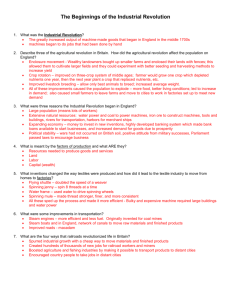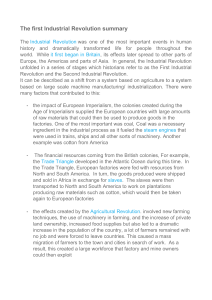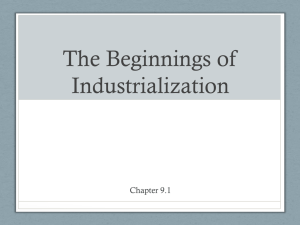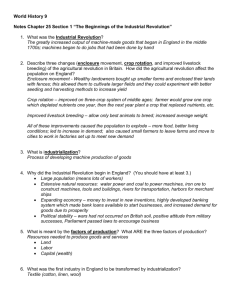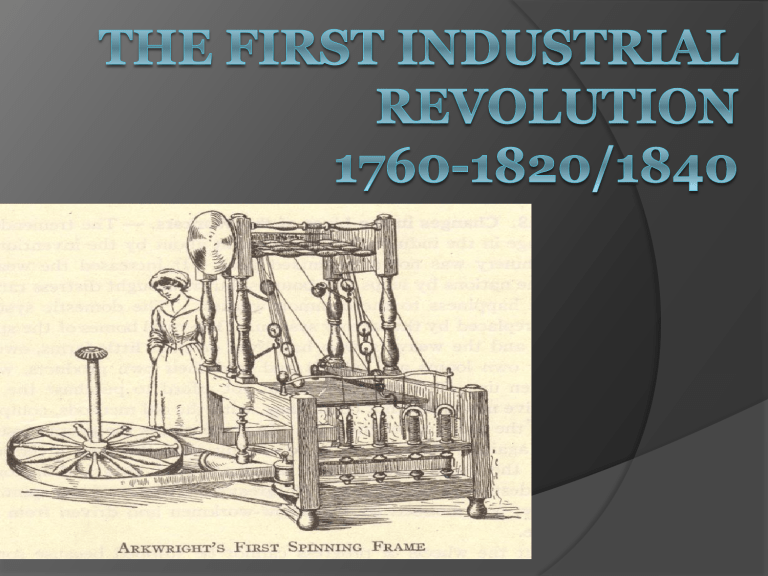
Prelude: The Population Explosion ○ ○ ○ ○ Famine War Disease Stricter quarantine measures ○ The elimination of the black rat Historical Significance of the Industrial Revolution The Industrial Revolution changed human life drastically More was created in the last 250+ years than in the previous 2500+ years of known human history What was the Industrial Revolution? The Industrial Revolution refers to the greatly increased output of machine made goods that began in England in the 1700s The Industrial Revolution Machines were invented which replaced human labor New energy sources were developed to power the new machinery – water, steam, electricity, oil (gas, kerosene) Increased use of metals and minerals Aluminum, coal, copper, iron, etc. Britain Takes the Lead Great Britain’s advantages: Plentiful iron and coal A navigable river system Colonies that supplied raw materials and bought finished goods A government that encouraged improvements in transportation and used its navy to protect British trade Development of the Domestic System of Production Domestic system developed in England Late 1600s-late 1800s Domestic system could not keep up with demand The Industrial Revolution Transportation improved Ships ○ Wooden ships → Iron ships → Steel ships ○ Wind-powered sails → Steam-powered boilers Trains Automobiles Communication improved Telegraph Telephone Radio Background of the Industrial Revolution Scientific Revolution Intellectual Revolution Encouraged learning and the search for better and newer ways of doing things Agricultural Revolution Landowners experimented in their enclosures Seed drill Crop rotation Livestock breeding The Seed Drill Innovations: The Threshing Machine Townshend’s Four-Field System crop rotation example Charles “Turnip” Townshend Factory System Developed to replace the domestic system of production Faster method of production Workers concentrated in a set location Production anticipated demand For example: Under the domestic system, a woman might select fabric and have a businessperson give it to a home-based worker to make into a dress. Under the factory system, the factory owner bought large lots of popular fabrics and had workers create multiple dresses in common sizes, anticipating that women would buy them. Why the Industrial Revolution Started in England Capital for investing in the means of production Colonies and Markets for manufactured goods Raw materials for production Workers Merchant marine Geography England’s Resources: Capital merchants had the capital to invest in the factory system – money to buy buildings, machinery, and raw materials Its colonies gave England access to enormous markets and vast amounts of raw materials possessed the necessary raw materials to create the means of production (coal, iron) English people could freely travel from the countryside to the cities World’s largest merchant fleet England’s Resources: Geography England is the political center of Great Britain, an island Great Britain did not suffer fighting on its land during the wars of the 18th century Island has excellent harbors and ports Damp climate benefited the textile industry (thread did not dry out) Government stable No internal trade barriers Inventions Spur Industrialization Weavers work faster-flying shuttles/ spinning jennies Water frame uses H2O to drive spinning wheels Power loom- spinning mules speed up production Move machinery to factories “Necessity Is the Mother of Invention” Spinning machine Need to speed up weaving Power loom created “Necessity Is the Mother of Invention” Power loom Increased demand for raw cotton Invention of the cotton gin “Necessity Is the Mother of Invention” Cotton gin Demands for stronger iron Improvements in iron smelting and the development of steel (Bessemer process) “Necessity Is the Mother of Invention” As more steampowered machines were built, factories needed more coal to create this steam Mining methods improved to meet the demand for more coal •The process of inventing never ends •One invention inevitably leads to improvements upon it and to more inventions Bell Work January 13, 2014 Turn your project into the stack at the front Also, turn your current event into your box How was your second drawing of the urban village different than your first? Were you surprised at how fast these towns grew in just 100 years? What factors did you think about when laying out your town? The Birth and Growth of the Textile Industry John Kay (English) Flying shuttle, 1733 Hand-operated machine which increased the speed of weaving James Hargreaves (English) Spinning jenny, 1765 Home-based machine that spun thread 8 times faster than when spun by hand Richard Arkwright (English) Water frame, 1769 Water-powered spinning machine that was too large for use in a home – led to the creation of factories Samuel Crompton (English) Spinning mule, 1779 Combined the spinning jenny and the water frame into a single device, increasing the production of fine thread Edward Cartwright (English) Power loom, 1785 Water-powered device that automatically and quickly wove thread into cloth Eli Whitney (American) Cotton gin, 1793 Device separated raw cotton from cotton seeds, increasing the cotton supply while lowering the cost of raw cotton Elias Howe (American) Sewing machine, 1846 Speed of sewing greatly increased These machines were so large. They were placed in large buildings called factories Development of Steam Engines Early water power involved mills built over fast-moving streams and rivers Problems-rivers far removed, not enough power, prone to drying James Watt, Scotland (1769) Improved Newcomen’s steam engine to power machinery Steam Engines By 1800, steam engines were replacing water wheels as sources of power for factories Factories relocated near raw materials, workers, and ports Cities grew around the factories built near central England’s coal and iron mines Manchester, Liverpool Transportation Increased production Search for more markets and raw materials Before the Industrial Revolution •Canal barges pulled by mules •Ships powered by sails •Horse-drawn wagons, carts, and carriages After the Industrial Revolution •Trains •Steamships •Trolleys •Automobiles Better and faster means of transportation Transportation Revolution Robert Fulton (American) • Steamboat (1807) • Sped water transportation Thomas Telford and John McAdam (British) • Macadamized roads (18101830) • Improved roads Gottlieb Daimler (German) • Gasoline engine (1885) • Led to the invention of the automobile George Stephenson (English) • Locomotive (1825) • Fast land transport of people and goods Rudolf Diesel (German) • Diesel engine (1892) • Cheaper fuel Orville and Wilbur Wright (American) • Airplane (1903) • Air transport Steamboats Robert Fulton invented the steamboat in 1807 The Clermont operated the first regular steamboat route, running between Albany and New York City 1819 – the Savannah used a steam engine as auxiliary power for the first time when it sailed across the Atlantic Ocean 1836 – John Ericsson invented a screw propeller to replace paddle wheels 1838 – the Great Western first ship to sail across the Atlantic on steam power alone, completing the trip in 15 days Macadamized Roads Strong, hard roads invented by Thomas Telford and John McAdam Improvement over dirt and gravel roads Macadamized roads have a smooth, hard surface that supports heavy loads without requiring a thick roadbed Modern roads are macadamized roads, with tar added to limit the creation of dust Railroads 1830 – Stephenson’s “Rocket” train traveled the 40 miles between Liverpool and Manchester in 1 ½ hours 1830-1870 – railroad tracks went from 49 miles to over 15,000 miles Steel rails replaced iron rails 1869 – Westinghouse’s air brake made train travel safer Greater train traveling comfort – heavier train cars, improved road beds, and sleeping cars Communications Revolution Samuel F.B. Morse (American) Alexander Graham Bell (American) • Telegraph (1844) • Rapid communication across continents • Telephone (1876) • Human speech heard across continents Cyrus W. Field (American) • Atlantic cable (1866) • United States and Europe connected by cable Guglielmo Marconi (Italian) Lee de Forest (American) • Wireless telegraph, an early form of the radio (1895) • No wires needed for sending messages • Radio tube (1907) • Radio broadcasts could be sent around the world Vladimir Zworykin (American) • Television (1925) • Simultaneous audio and visual broadcast Bell Work January 14 Review Questions Pick two to answer thoroughly 1. What was the Industrial Revolution? 2. Describe at least three developments of the Industrial Revolution. 3. Compare and contrast the domestic and factory methods of production. 4. Why did the Industrial Revolution begin in England? 5. Explain why one invention or development leads to another. Review Questions 6. Explain how developments in the textile industry sparked the Industrial Revolution. 7. Describe at least three developments in the area of transportation. 8. Describe at least three developments in the field of communications. 9. Considering the conditions necessary for industrialization to occur, how well equipped is the undeveloped world for becoming industrialized? Are modern undeveloped nations in a better or worse position than 18th- and 19th-century England? Industrialization: Section 2 European cities go through a period of urbanization because of the factory system This caused living conditions to be terrible Sickness was widespread (cholera) Average worker spent 14hours, 6days Dangerous industry-coal mines Class Tension New money-factory owners, shippers, and merchants became middle class Upper-doctors, lawyers Lower-factory overseers Working class-machines replaced them Luddites-destroyed machines in factories and rioted Hey, some good things Created jobs Money! Increased production of goods Hope of improvement Expanded educational opportunities Took a while for everybody but eventually conditions improved in the work place Bell Work January 15, 2014 What early industries mechanized in the United States? Why did Belgium lead Europe in adopting industrialization? How did the Industrial Revolution shift the world balance of power? Industrialization Spreads Section: 3 Samuel Slater- built a spinning machine from memory in U.S. Francis Lowell-mechanized every stage of manufactured cloth in U.S. Women flocked to mill jobs U.S. went through Industrialization in late 1800s Resources, inventions, swelling population were contributors Railroads played a major role Corporations Entrepreneurs sold shares of stock or rights of ownership These businesses became corporations Gives the ability to raise large amounts of capital Standard Oil Carnegie Steel Europe Industrializes William Cockerill made his way to Belgium, his son built large industry there Germany had pockets of industry Imported British engineers and build railways Regions in Europe began to Industrialize (ex. Northern Italy-textile) Social structure and geography halted it elsewhere Impact Industrialized countries exploited overseas markets for resources Imperialism was born Gave Europe great power Developed a middle class Created a movement for social reform Philosophers: Section 4 Adam Smith believed in the term laissez faire Policy of letting owner of industry and business set working conditions without interference Wrote about in The Wealth of Nations Philosophers Capitalism-economic system in which the factors of production are privately owned and money is invested in business ventures to make a profit Malthus -An Essay on the Principle of Population epidemics and wars are necessary Ricardo- Principles of Political Economy and Taxation-a permanent underclass Philosophers Jeremy Bentham-utilitarianism-people should judge things based on their usefulness Individuals should be free to pursue interests without interference of the state Questioned unregulated capitalism Pushed for reforms Utopian leaders-Robert Owen-improved working conditions, attempted to create Utopia in Indiana Philosophers French Reformers Charles Fourier and Saint-Simon Socialism-factors of production are owned by the public and operate for the welfare of all Philosophers Karl Marx and Freidrich Engels The Communist Manifesto Middle class “haves” or bourgeoisie “have nots” workers or proletariats Predicted that the workers would overthrow owners Marx Marx believed factories would drive small businesses out, leaving anumber of manufacturers to control all wealth Proletariat would revolt and a classless society would develop Called communism All good would be shared equally Reforms Workers joined together to form unions Engaged in bargaining with employers if refused workers would strike Britain-Combination Acts outlawed unions but were repealed in 1824 1886- U.S.- American Federation of Labor led successful strikes Reforms Factory Act of 1833-illegal to hire children under 9 Could not work more than 8 hours a day 1842- Mines Act prevented women and children from working underground 1847- limited workday to 10 hours Reform Movement William Wilberforce was influential in getting the slave to end in Britain in 1833 US-1865-Puerto Rico-1873-Brazil-1888 Women activists met at the International Council for Women in 1888. Horace Mann-advocated for free public education Alexis de Tocqueville sought to reform the conditions in prison

